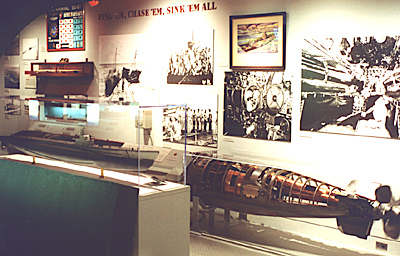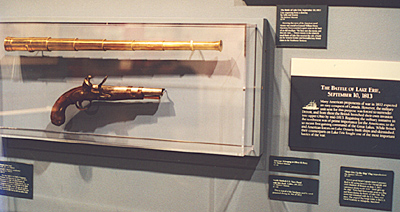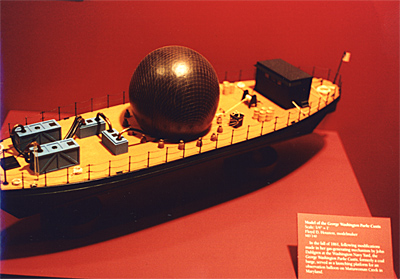Defending the Seas
Ah, the second favorite spot in the museum dedicates a long room to military actions and technology. Since you can't particularly insert a battleship into the museum, photos, drawings, and other artwork have to do.
Nonetheless, a few things come to mind. The replica of the Monitor turret is one and occupies a central area of the hall. Here you can enter and walk around, see the cannons, and read about the construction and action of the ship.
An aircraft carrier pilot ready room has a number of chairs and shows a 17-minute film about flight operations.
There's nothing like a WWII mine to ruin a merchant ship's day--you'll find one against the wall. Nice size--you just don't see that many in museums.
 Find 'Em, Chase 'Em, Sink 'Em All
Find 'Em, Chase 'Em, Sink 'Em All
Next is the submarine exhibit underneath that phrase. It's a little tough to photograph as you enter the area from the tail of the torpedo and walk forward.
The submarine is the USS Narwal and receives a lot of attention with a number of fittings, the helm, and a stack of bunks stretching across part of a section. A torpedo with transparent case rests at knee level, and a short demonstration explains its operation, including spinning propeller. The various sections that light up as the narrator explains each component.
 Commodore Perry's spyglass and pistol adorn another wall explaining ship actions during the War of 1812.
Commodore Perry's spyglass and pistol adorn another wall explaining ship actions during the War of 1812.
The information panel reads:
- "The Battle of Lake Erie
September 10, 1813
Many American proponents of war in 1812 expected an easy conquest of Canada. However, the military unit sent for this purpose was forced to surrender Detroit, and from there the British launched their own invasion into upper Ohio by mid-1813. Regaining the miltary initiative in the northwest was of prime importance for the Americans, to do so first meant gaining command of the Great Lakes. While British and American forces on Lake Ontario built ships and skirmished, their counterparts on Lake Erie fought one of the most important battles of the war."
 Ship models adorn the cases on the other side of the room. One of the most unusual is the George Washington Parke Custis used during the American Civil War, complete with balloon on board.
Ship models adorn the cases on the other side of the room. One of the most unusual is the George Washington Parke Custis used during the American Civil War, complete with balloon on board.
The card reads:
- "In the fall of 1861, following modifications to her gas-generating mechanism by John Dahlgren at the Washington Navy Yard, the George Washington Parke Custis, formerly a coal barge, served as a launching platform for an observation balloon on Mattawaman (?) Creek in Maryland."
As you exit this gallery, you come to a galley, which means vending machines.
More of the Mariners' Museum
- Introduction
Chesapeake Bay Gallery
Monitor Restoration
Age of Exploration
Defending the Seas
Collections Gallery
Great Hall of Steam
Crabtree Collection of Miniature Ships
Other Galleries
Gift Shop and More
Back to List of Historic Sites
Back to Travel Master List
Back to MagWeb Master List of Magazines
© Copyright 2003 by Coalition Web, Inc.
This article appears in MagWeb (Magazine Web) on the Internet World Wide Web.
Other articles covering military history and related topics are available at http://www.magweb.com